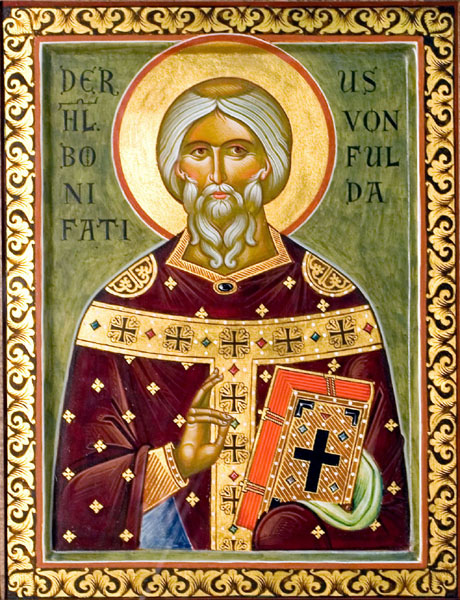Orthodox Saints of the Pre-Schism See of Rome

5th June
ADALAR (ADALHER) of ERFURT, fellow worker with St. Boniface of Mainz (vide infra) in the evangelisation of Friesland (northern Netherlands). St. Adalar was martyred in 755, along with St. Boniface, at Dokkum in Friesland.
BONIFACE of MAINZ, Enlightener of Germany, following education at monasteries at Exeter and Winchester (England), and numerous years as a monastic, St. Boniface, responding to a missionary calling, left England in 716 to evangelise Friesland (northern Netherlands). Several years later, Pope St. Gregory II (11th February) consecrated St. Boniface bishop (later elevating him to Archbishop, and then Metropolitan beyond the Rhine River) and charged him with the conversion of the Germanic peoples. St. Boniface established his See at Mainz (Germany), and for over twenty years, blessed by God, St. Boniface brought many to Christ. He then resigned his See and returned to Friesland to finish the work he had begun decades earlier. At Dokkum in Friesland, St. Boniface and fifty-two of his companions, including SS. Adalar (vide supra), and Eoban (vide infra), were martyred in 755 by pagans they were trying to convert. St. Boniface was interred at Fulda Abbey, in the present-day German state of Hesse.
EOBAN, an Irishman and member of SS. Willibrord of Echternach (7th November) and Boniface of Mainz's (vide supra) mission to Friesland (northern Netherlands). Appointed Bishop of Utrecht (central Netherlands) by St. Boniface, St. Eoban was one of the martyrs along with SS. Boniface (vide supra) and Adalar (vide supra) in 755 at Dokkum, Friesland.
FELIX of FRITZLAR, a monk at the Abbey of St. Peter (Kloster St. Peter) in Fritzlar (in present-day nothern Hesse, Germany) and contemporary of St. Boniface of Mainz (vide supra). St. Felix was martyred circa 790 by a pagan mob.
Let us stand fast in what is right and prepare our souls for trial. . . . Let us be neither dogs that do not bark nor silent onlookers nor paid servants who run away before the wolf.
— St. Boniface
FLORENTIUS, JULIAN, CYRIACUS, MARCELLINUS, and FAUSTINUS (Martyrs of Perugia), a group of martyrs who were beheaded in 250 at Perugia during the Decian Persecution.
MEINWERK of PADERBORN, a member of the House of Immedinger, St. Meinwerk held several ecclesiastical positions, including Chaplain to the Court of Holy Roman Emperor Otto III (r. 996–1002), prior to being consecrated Bishop of Paderborn (in present-day North Rhine-Westphalia, Germany), in 1009. During the twenty-seven years St. Meinwerk served the See of Paderborn, he undertook many construction projects, building monasteries and churches, which earned him the sobriquet ‘the Builder Bishop'. St. Meinwerk reposed in 1036, and was buried in the crypt of the church at Abdinghof Abbey in Paderborn.
SANCTIUS (SANCHO, SANCIUS) of CÓRDOBA, a life-long Christian and native of Gaul (France) captured during war with the Moors. St. Sanctius was taken to Córdoba where he was educated at the court of Emir Abd ar-Rahman II (r. 822–852) and then enrolled in the Emir’s Guards. St. Sanctius was martyred in 851 by impalement for his refusal to convert to Islam.
TUDNO of CAERNARVON, St. Tudno was a sixth century Welsh saint for whom Llandudno in Gwynedd, Wales is named. No other information on his life is extant.
WACCAR, GUNDEKAR, ELLEHER, and HATHAWULF, monks and members of the group working with St. Boniface (vide supra) they were martyred at Dokkum, Friesland (northern Netherlands) in 754.
Prior to the Schism the Patriarchate of Rome was Orthodox, and fully in communion with the Orthodox Church. As Saint John of Shanghai and San Francisco +1966 said “The West was Orthodox for a thousand years, and her venerable Liturgy is far older than any of her heresies”.
Details of British Saints excerpted from Orthodox Saints of the British Isles.
Details of continental saints from these sources.
In many cases there are several spelling versions of the names of saints from the British Isles. I use the Oxford Dictionary of National Biography version as the primary version with the more prevalent version in parenthesis e.g. Ceadda (Chad) of Lichfield.

